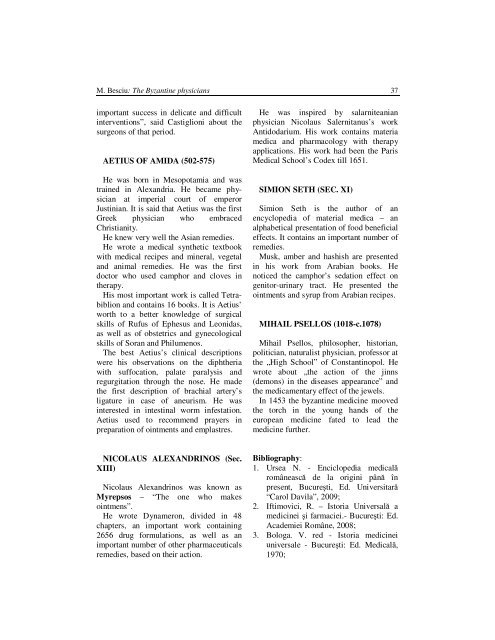Series VI: Medical Sciences – SUPPLEMENT ... - Krongres
Series VI: Medical Sciences – SUPPLEMENT ... - Krongres
Series VI: Medical Sciences – SUPPLEMENT ... - Krongres
You also want an ePaper? Increase the reach of your titles
YUMPU automatically turns print PDFs into web optimized ePapers that Google loves.
M. Besciu: The Byzantine physicians 37<br />
important success in delicate and difficult<br />
interventions”, said Castiglioni about the<br />
surgeons of that period.<br />
AETIUS OF AMIDA (502-575)<br />
He was born in Mesopotamia and was<br />
trained in Alexandria. He became physician<br />
at imperial court of emperor<br />
Justinian. It is said that Aetius was the first<br />
Greek physician who embraced<br />
Christianity.<br />
He knew very well the Asian remedies.<br />
He wrote a medical synthetic textbook<br />
with medical recipes and mineral, vegetal<br />
and animal remedies. He was the first<br />
doctor who used camphor and cloves in<br />
therapy.<br />
His most important work is called Tetrabiblion<br />
and contains 16 books. It is Aetius’<br />
worth to a better knowledge of surgical<br />
skills of Rufus of Ephesus and Leonidas,<br />
as well as of obstetrics and gynecological<br />
skills of Soran and Philumenos.<br />
The best Aetius’s clinical descriptions<br />
were his observations on the diphtheria<br />
with suffocation, palate paralysis and<br />
regurgitation through the nose. He made<br />
the first description of brachial artery’s<br />
ligature in case of aneurism. He was<br />
interested in intestinal worm infestation.<br />
Aetius used to recommend prayers in<br />
preparation of ointments and emplastres.<br />
NICOLAUS ALEXANDRINOS (Sec.<br />
XIII)<br />
Nicolaus Alexandrinos was known as<br />
Myrepsos <strong>–</strong> “The one who makes<br />
ointmens”.<br />
He wrote Dynameron, divided in 48<br />
chapters, an important work containing<br />
2656 drug formulations, as well as an<br />
important number of other pharmaceuticals<br />
remedies, based on their action.<br />
He was inspired by salarniteanian<br />
physician Nicolaus Salernitanus’s work<br />
Antidodarium. His work contains materia<br />
medica and pharmacology with therapy<br />
applications. His work had been the Paris<br />
<strong>Medical</strong> School’s Codex till 1651.<br />
SIMION SETH (SEC. XI)<br />
Simion Seth is the author of an<br />
encyclopedia of material medica <strong>–</strong> an<br />
alphabetical presentation of food beneficial<br />
effects. It contains an important number of<br />
remedies.<br />
Musk, amber and hashish are presented<br />
in his work from Arabian books. He<br />
noticed the camphor’s sedation effect on<br />
genitor-urinary tract. He presented the<br />
ointments and syrup from Arabian recipes.<br />
MIHAIL PSELLOS (1018-c.1078)<br />
Mihail Psellos, philosopher, historian,<br />
politician, naturalist physician, professor at<br />
the „High School” of Constantinopol. He<br />
wrote about „the action of the jinns<br />
(demons) in the diseases appearance” and<br />
the medicamentary effect of the jewels.<br />
In 1453 the byzantine medicine mooved<br />
the torch in the young hands of the<br />
european medicine fated to lead the<br />
medicine further.<br />
Bibliography:<br />
1. Ursea N. - Enciclopedia medical�<br />
româneasc� de la origini pân� în<br />
present, Bucure�ti, Ed. Universitar�<br />
“Carol Davila”, 2009;<br />
2. Iftimovici, R. <strong>–</strong> Istoria Universal� a<br />
medicinei �i farmaciei.- Bucure�ti: Ed.<br />
Academiei Române, 2008;<br />
3. Bologa. V. red - Istoria medicinei<br />
universale - Bucure�ti: Ed. <strong>Medical</strong>�,<br />
1970;


